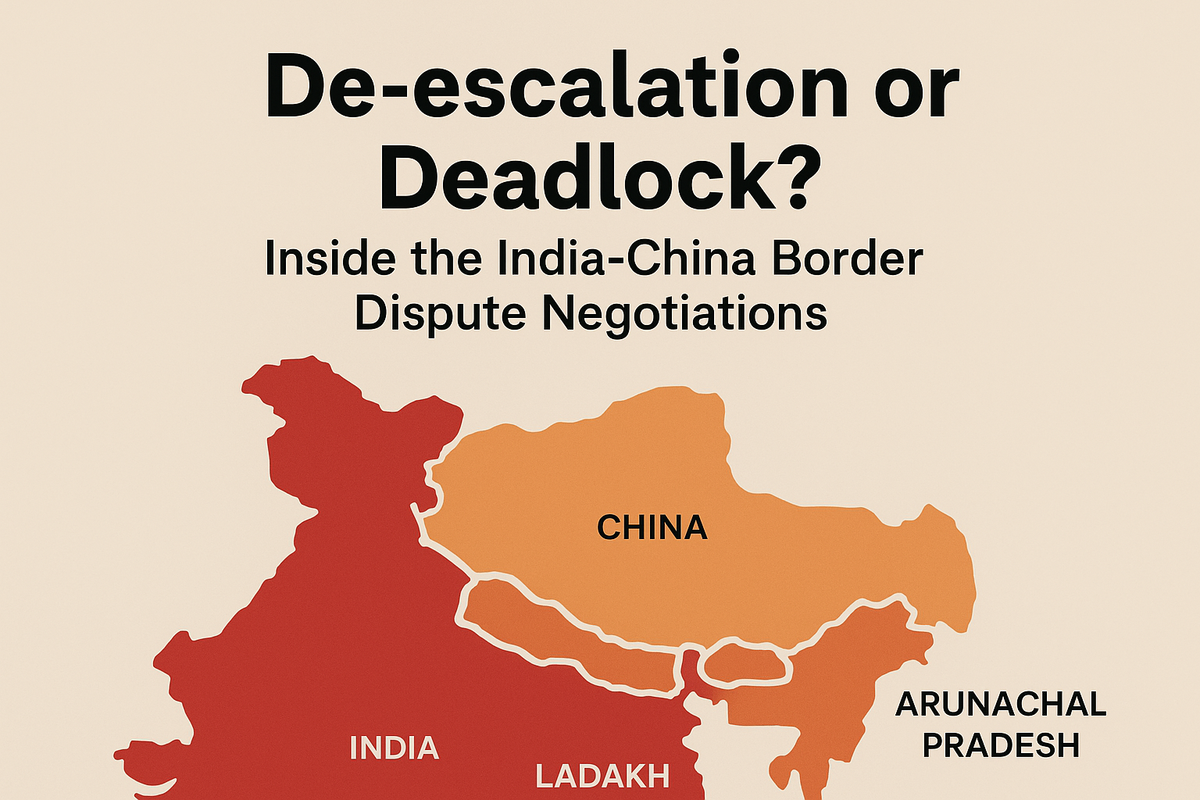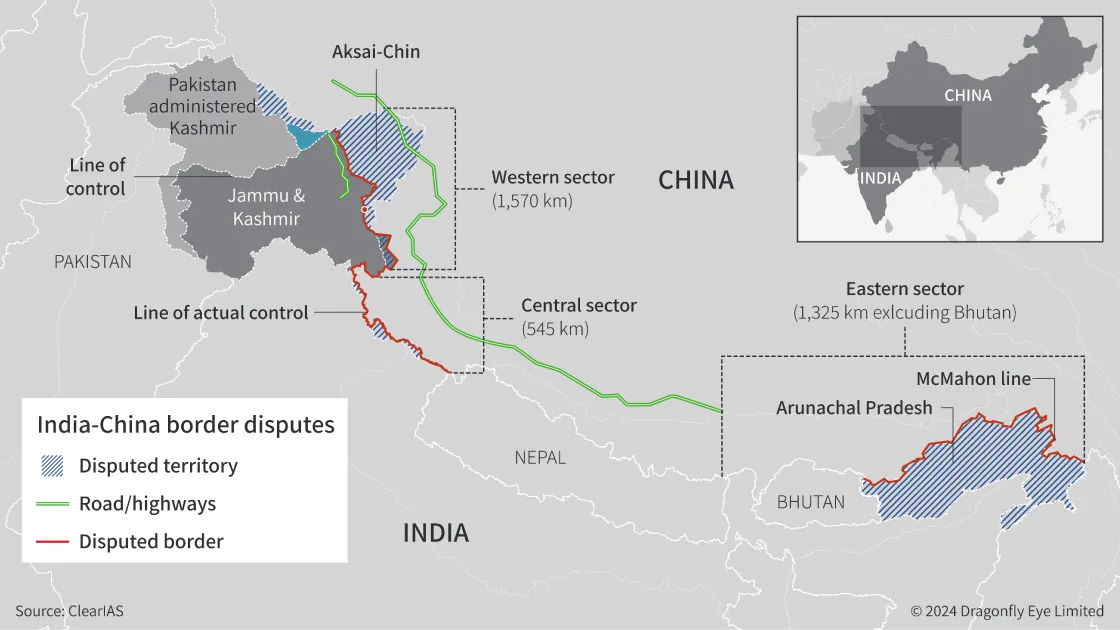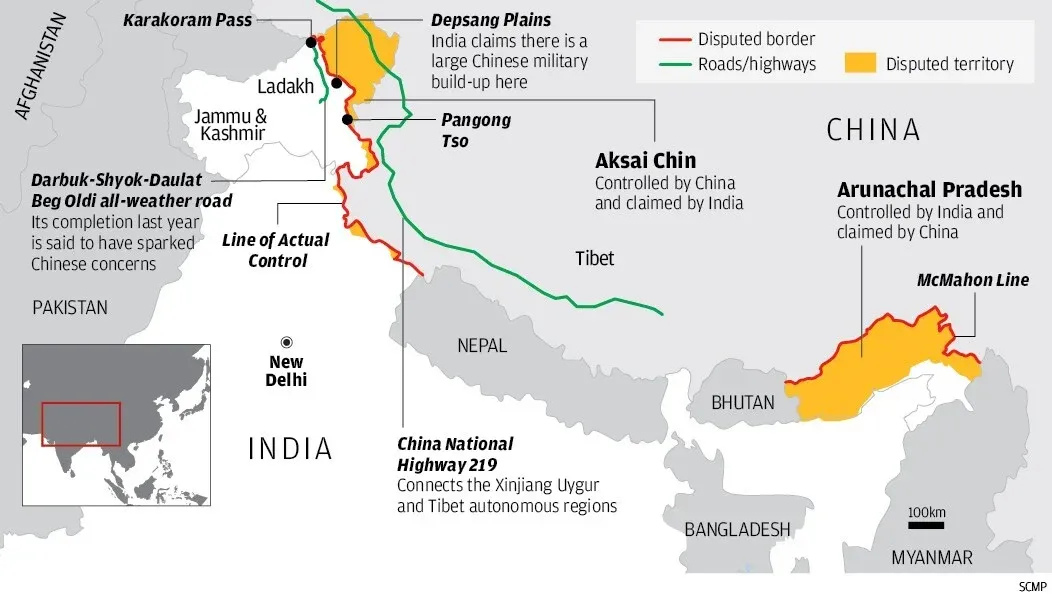De-Escalation or Deadlock? Inside the India-China Border Dispute Negotiations
Explore the high-stakes India-China border negotiations, analyzing if they'll lead to lasting peace or another stalemate.

Written by Lavanya, Intern, Allegedly The News
NEW DELHI, August 19, 2025
In the shadow of the world's highest mountains, a diplomatic tango of immense consequence is unfolding. The latest round of talks between India and China—the 24th round of Special Representatives' talks- is not just about drawing lines on a map. They are a crucial litmus test for the future of Asia’s two most powerful and populous nations. Since the deadly Galwan Valley clash of June 2020, the relationship has been frozen in a state of armed coexistence, with tens of thousands of troops, artillery, and advanced weaponry amassed along the Line of Actual Control (LAC). This investigative report breaks down the complex layers of these high-stakes negotiations, from the on-the-ground realities to the global forces shaping their outcome.
The Unresolved Line: A History of Mistrust
The root of the border dispute is the absence of a clearly demarcated boundary. The 3,488 km-long LAC, the de facto border, is largely a product of the 1962 Sino-Indian War. While both sides have signed numerous agreements since the 1990s to maintain peace and tranquility, these protocols have failed to prevent the escalations of recent years. The 2020 Galwan clash, in which 20 Indian soldiers and at least four Chinese soldiers lost their lives, marked a catastrophic breakdown of these mechanisms. It forced both nations to re-evaluate their entire relationship.
Timeline of Tensions:
- 1914: The British-proposed McMahon Line is rejected by China, laying the foundation for the dispute in the Eastern Sector.
- 1962: A brief but decisive war solidifies China's control over Aksai Chin and establishes the LAC.
- 2017: A 73-day standoff at Doklam, near the India-Bhutan-China tri-junction, brings the two armies to the brink of conflict.
- 2020: The Galwan Valley clash shatters decades of relative peace, leading to a massive military buildup along the LAC in Ladakh.
- 2021-2024: Multiple rounds of Corps Commander-level talks achieve partial disengagement at some friction points like Pangong Tso and Gogra-Hotsprings, but key areas like Depsang and Demchok remain points of contention.
The lack of a formal border has created a cycle of "salami-slicing", a strategy where one side makes small, incremental incursions to secure tactical advantage. India's recent infrastructure projects, including a new road to a high-altitude air base, have been cited as a key trigger by some analysts for China's increased assertiveness.
The Diplomatic Battleground: Objectives and Asymmetries.
The current negotiations, spearheaded by National Security Advisor Ajit Doval and Chinese Foreign Minister Wang Yi, have distinct and often conflicting objectives.
India’s Position: The Three Mutuality Doctrine India's stance is unequivocal: "Peace and tranquility on the border is the prerequisite for the normal development of the relationship." External Affairs Minister S. Jaishankar has repeatedly stated that ties cannot be "business as usual" while a massive military presence remains on the border. New Delhi seeks:
- Complete Disengagement: A full withdrawal of troops from all remaining friction points, including the critical Depsang Plains.
- De-escalation: A broader reduction of troop levels and heavy weaponry from forward positions along the entire LAC to restore the pre-2020 status quo.
- Restoration of Trust: A return to the principles of mutual respect, sensitivity, and interest in all aspects of the relationship.
China’s Position: Compartmentalize and Move On. In contrast, China has sought to compartmentalize the border issue, arguing it should not impede cooperation in other areas like trade and global governance. Beijing's primary goals are:
- Stabilization: Maintain stability on the border while focusing on economic and diplomatic engagement.
- Economic Normalization: Resume full economic and trade cooperation, which has been impacted by India's ban on Chinese apps and investment regulations.
- Countering Western Influence: Weaken India's growing strategic alignment with the United States and the Quad (Quadrilateral Security Dialogue) by offering a path to improved bilateral ties.
The fundamental asymmetry in these positions is the greatest challenge. India wants to use the broader relationship as leverage to resolve the border issue, while China wants to isolate the border dispute to a separate, ongoing mechanism.

The Global Chessboard: How World Powers are Watching
The India-China border negotiations are not a purely bilateral affair. They are a microcosm of the intense geopolitical competition reshaping the world.
- The U.S. Factor: The relationship between India and the U.S. has deepened significantly in recent years, particularly in security and defense. The U.S. views India as a crucial partner in its Indo-Pacific strategy to counter China's assertiveness. However, the recent imposition of tariffs by the U.S. on Indian goods, under the new administration, has introduced a wrinkle. This has subtly pushed New Delhi to re-evaluate its foreign policy and consider a more balanced approach, making China's diplomatic overtures more appealing.
- Russia's Role: Russia, a long-standing partner to both nations, has a vested interest in stability. While it has not been a direct mediator, it has used platforms like the Shanghai Cooperation Organisation (SCO) to encourage dialogue. The fact that Prime Minister Narendra Modi is slated to visit China for the SCO summit is a testament to this platform's importance as a neutral ground for engagement.
- The Quad: The Quad—a security grouping of India, the U.S., Japan, and Australia—is viewed by China as an attempt to contain it. India's participation in the Quad signals its commitment to a free and open Indo-Pacific, a position that clashes directly with China's expansionist ambitions. The outcome of the current negotiations will have a direct bearing on the future dynamics of the Quad.
A senior analyst from the Observer Research Foundation, Manoj Joshi, noted that "settling the boundary issue between the two countries requires political compromise at the highest political level." He added, "The two countries are still talking past each other when it comes to the border dispute and issues surrounding it." This illustrates the deep chasm that remains between the two nations' strategic perspectives.
Economic Rivalry: Trade, Tariffs, and Tech
While military tensions dominate headlines, the economic dimension of the rivalry is equally critical. The two nations are global economic powerhouses, and their trade relationship, currently valued at over $130 billion, is deeply unbalanced in China's favor.
- The Trade Deficit: India's trade deficit with China has been a long-standing concern. Following the 2020 clash, India took a series of measures to reduce this dependence, including banning hundreds of Chinese apps and imposing stricter regulations on foreign direct investment from border-sharing nations.
- Strategic Imports: China's recent willingness to ease restrictions on exports of critical items like urea fertilizers, rare earth magnets, and pharmaceuticals to India is a significant sign of a potential thaw. This is a direct response to India's requests and an acknowledgement of its economic needs.
- Technology Transfers: As part of this renewed economic engagement, China is also facing internal pressure to scrutinize technology transfer agreements, particularly in strategic sectors like electric vehicles. This highlights China's desire to maintain its technological edge while also seeking to improve trade relations with India.
The economic rivalry is not just about trade figures; it's a battle for influence and self-reliance. India's "Atmanirbhar Bharat" (Self-Reliant India) initiative is a direct response to over-dependence on Chinese imports. A successful de-escalation of border tensions could pave the way for a more balanced and transparent economic partnership, but it will be a slow and arduous process.

The Verdict: What Happens Next?
The most likely outcome of the current talks is a managed de-escalation, not a comprehensive resolution. The recent disengagements from some friction points and the resumption of trade dialogue indicate a mutual recognition that the cost of a prolonged military and economic standoff is too high for both sides.
A full restoration of the pre-2020 status quo, however, remains a distant goal. The deep-seated mistrust, a history of unresolved territorial claims, and the ongoing competition for regional dominance make a lasting peace elusive. The talks will likely lead to further disengagements and confidence-building measures, but the heavily militarized LAC will remain a sensitive and volatile frontier.
Ultimately, the future of the India-China relationship will hinge on the leadership of Modi and Xi. Their upcoming meeting at the SCO summit will be a critical opportunity to move beyond the current deadlock. The world will be watching to see if they can finally chart a new course, or if their nations will remain trapped in a dance of shadows on the high Himalayan peaks.
Concluding Thoughts: The Elephant and the Dragon
The India-China border dispute is a unique case study in modern geopolitics. It is a conflict where two ancient civilizations, now modern powers, are grappling with a colonial legacy and competing for influence in a multipolar world. The negotiations are a testament to the idea that even in a time of great power rivalry, diplomatic engagement is essential to prevent a catastrophic conflict. Yet, they also prove that real peace requires more than just talk; it demands a fundamental shift in strategic thinking and a willingness to compromise on core issues of sovereignty. The "dragon-elephant tango," as some have called it, is fraught with risk, and the slightest misstep could have global consequences.
What is the enduring paradox of the India-China relationship?
The paradox lies in the simultaneous existence of a deeply intertwined economic relationship and an intensely adversarial security rivalry. Why have both nations allowed a $130 billion trade relationship to flourish, even as their armies have been eyeball-to-eyeball in one of the world's most difficult terrains? Does this economic dependence make them more or less likely to go to war?
A Call to Action for a New Era of Peace
For a lasting solution, the two nations must move beyond the military and diplomatic talks and focus on a new era of people-to-people engagement. How can cultural, academic, and scientific exchanges be used as a tool to build mutual trust and understanding, creating a foundation for peace that is more resilient than any military protocol?
Sources
The information in this report is based on verified public sources, including reports from the Ministry of External Affairs, statements from government officials, and analysis from leading geopolitical think tanks and news outlets.




